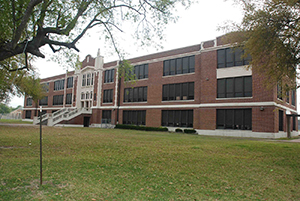LU remembers… photography exhibit shows changes through decades
Lamar University will celebrate its history with a talk and exhibit of photography documenting the area’s progress throughout the years at 2 p.m. on May 30 on the sixth floor of the Mary and John Gray Library.
 “The purpose is to show how things have changed through then-and-now photo comparisons,” said Steven Lewis, the event’s speaker and former instructor of biology at LU.
“The purpose is to show how things have changed through then-and-now photo comparisons,” said Steven Lewis, the event’s speaker and former instructor of biology at LU.
Lewis will present “Lamar Now and Then,” a series of photos from his Beaumont postcard collection that he has constructed during his 40 years as a photographer. The exhibit is on display on the first floor. The exhibit contrasts images of Lamar from previous eras with 2013 and 2014.
Lewis says that he was inspired to document city landmarks when he noticed the demolition of old buildings and wanted to preserve their images before they were destroyed.
“Back in 2011, I took photos of the Pig Stand on the corner of Calder and MLK, and now it is gone. In 2012, I took photos of the Oil City Brass Works building in downtown, and its gone too. If you don’t document what is here now, how will our children know what we had?” he said.
The photographs on the LU project postcards are hard to date exactly. But the cards have images of Lamar State College of Technology, meaning that the photo was taken prior to 1971 or of Lamar University, meaning that they were taken after 1971. The collection features photos of the original South Park High School, the location of South Park Junior College that would one day become Lamar University, as well as Cardinal Stadium, the old administration building, the entrance to the campus, the old student union, and the interior of the Setzer Student Center.
Since retiring from Lamar in 2011, Lewis has been collecting old photographs and Beaumont postcards. A few years ago, he discovered a treasure trove old photographs at the Texas Energy Museum. Helen Weber, the widow of Frank Weber, had donated the collection of 804 negatives and 675 prints to the Spindletop Museum in 1979. Although not all of the images were taken in Beaumont, many were, dating from the early 1900s to the 1940s. Lewis has given a presentation to the Jefferson County Historical Commission on aspects of Frank Weber’s life, based in part on those photographs. Included in the collection are photographs of a circus that was in Beaumont in 1907, with elephants and circus wagons parading down Pearl and Orleans streets. There also images of a 1901 Elks parade.
He will continue researching Beaumont history into the foreseeable future, Lewis said, with the goal to create at least two books on the history of Beaumont based on old photos and postcards. He has set no timeline on publication since much research is still needed to provide text for the books. Many of the Baby Boom generation are nostalgic for what their hometown was like when they were growing up, he said.
Lewis asserts, “We picture great societies by the structures that they leave behind. This is why we spend billions of dollars every year to see the pyramids of Giza, the Great Wall of China, the pyramid at Chichen Itza, and the cathedrals of Europe. A study done in 1977 of 122 structures in downtown Beaumont that should be preserved has shown that 89 (73 percent) have been demolished.”
“How can we know how great our society was if all we have to show are parking lots?” Lewis said.


